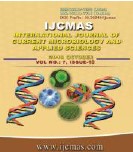


 National Academy of Agricultural Sciences (NAAS)
National Academy of Agricultural Sciences (NAAS)

|
PRINT ISSN : 2319-7692
Online ISSN : 2319-7706 Issues : 12 per year Publisher : Excellent Publishers Email : editorijcmas@gmail.com / submit@ijcmas.com Editor-in-chief: Dr.M.Prakash Index Copernicus ICV 2018: 95.39 NAAS RATING 2020: 5.38 |
A field experiment was conducted at the organic block of breeder seed production center, G.B.P.U.A&T, Pantnagar, Uttarakhand, India during the kharif season of 2015 and 2016 to study the effect of different organic, inorganic and integrated nutrient sources on the growth, yield and yield attributes of two basmati rice varieties. The experiments were laid out in Split plot design replicated thrice with eight treatments as main plots viz., T1: GM+FYM (AWD), T2: Organic (AWD), T3: FYM+VC (AWD), T4: SRI with FYM (AWD), T5: DSR + Soybean (LSI), T6: Organic control (CF), T7: Chemical control (CF), T8: Integrated (CF) and two varieties Type-3 and Taraori in the sub plots. The plant height at maturity was highest in treatment T8 which was at par with T7 in both the years. The organic treatments T1 and T3 were at par with T7 and T8 in terms of productive tillers/m−2, grain weight/panicle and thousand grain weight. However number of filled grains/panicle was non-significant in both the years. The grain yield ranged from 2.63-3.00 t/ha and the treatments T1, T3, T7 and T8 were at par in the in both the years 2015 and 2016. Further the results suggest that the organic manures such as vermicompost, FYM and green manures have equal potential in comparison to chemical and integrated fertilizers for rice production.
 |
 |
 |
 |
 |